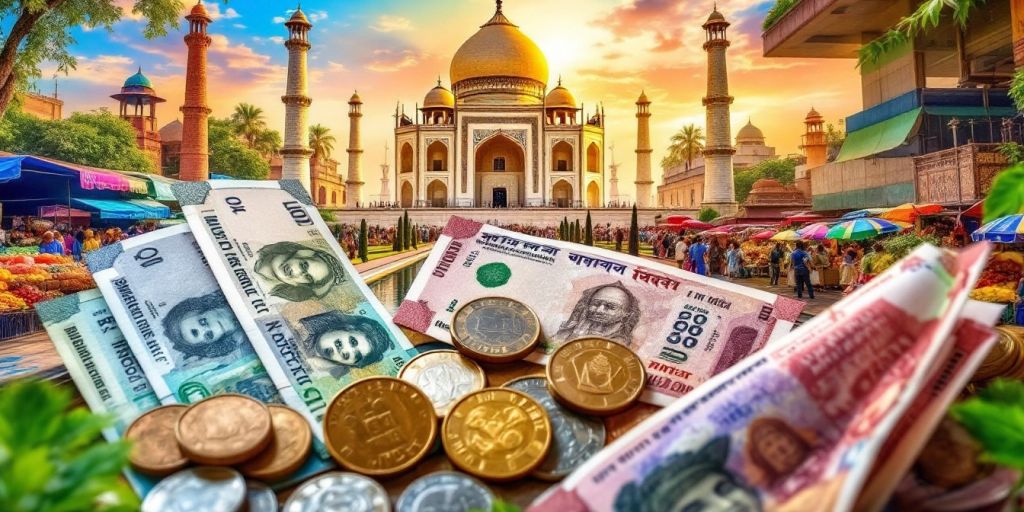Traveling to India is an exciting adventure, but understanding the right currency to use is crucial for managing your expenses. The official currency in India is the Indian Rupee (INR), and knowing how to handle your money can make your trip smoother. This guide will help you navigate currency exchange, card usage, and best practices for spending wisely in India.
Key Takeaways
- The Indian Rupee (INR) is the only accepted currency in India; USD is not commonly used.
- It’s smart to exchange some money to INR before your trip for better rates.
- Using a travel debit card can help you avoid high fees and make transactions easier.
- Always carry some cash for small purchases, as not all places accept cards.
- Be aware of potential scams and keep your money safe while traveling.
Understanding the Official Currency in India

What Is the Indian Rupee?
The official currency of India is the Indian Rupee (INR). It is managed by the Reserve Bank of India. You will see prices marked with the symbol ₹ in shops and restaurants. If you’re planning to travel, it’s essential to familiarize yourself with this currency.
Denominations of Indian Rupee
When you’re in India, you’ll encounter various denominations of the rupee:
- Banknotes: 1, 2, 5, 10, 20, 50, 100, 200, 500, 2000 INR
- Coins: 1, 2, 5, 10 INR; 50 paise
| Denomination Type | Value (INR) |
|---|---|
| Banknotes | 1, 2, 5, 10, 20, 50, 100, 200, 500, 2000 |
| Coins | 1, 2, 5, 10; 50 paise |
Role of the Reserve Bank of India
The Reserve Bank of India plays a crucial role in regulating the currency. It ensures the stability of the rupee and manages the supply of money in the economy. Understanding this can help you appreciate the value of your money while traveling.
Remember: The Indian Rupee has a rich history, having been a silver-based currency during much of the 19th century, which had severe consequences on its standard value.
By knowing about the Indian Rupee, you can better manage your finances while enjoying your trip. For more tips on handling money in India, check out the services offered by Tripcorner.
Exchanging Currency Before Traveling to India

Benefits of Exchanging Currency in Advance
Exchanging your money before you travel can save you time and money. You often get better rates and avoid high fees at airports. Here are some benefits:
- Better exchange rates: You can find more favorable rates before you leave.
- Convenience: Having cash ready means you can start spending right away.
- Avoiding airport fees: Airports usually charge higher fees for currency exchange.
Where to Exchange USD to INR
You have several options for exchanging your money:
- Banks: They often offer competitive rates.
- Currency exchange services: Look for reputable services in your area.
- Online services: Some websites allow you to order currency in advance.
Understanding Exchange Rates
Knowing the exchange rate is crucial. The mid-market rate is a good benchmark. For example, if the rate is 1 USD = 0.9138 INR, you should aim for rates close to this. Always compare rates before exchanging.
Remember, exchanging currency in advance can help you avoid unnecessary costs and make your trip smoother. For more tips on managing your travel funds, check out Tripcorner.
Using Debit and Credit Cards in India
Acceptance of Cards in Major Cities
In India, using debit and credit cards is quite common, especially in major cities. Most restaurants, hotels, and larger shops accept card payments. However, you should always carry some cash for smaller vendors and markets where cards may not be accepted.
Using Travel Debit Cards
Travel debit cards can be a smart choice for your trip. They often come with low or no foreign transaction fees, making them ideal for spending and cash withdrawals. Here are some benefits of using a travel debit card:
- No interest charges on your spending.
- Secure since they are not linked to your main bank account.
- Easy to manage through an app, allowing you to switch currencies quickly.
Potential Fees and Charges
While using cards is convenient, be aware of potential fees. Here are some tips to avoid extra costs:
- Choose a card with no foreign transaction fees. This can save you money on every purchase.
- Check your card agreements before traveling to understand any charges.
- Avoid using credit cards for cash withdrawals, as they often incur high fees and interest immediately.
Always keep a mix of cash and cards for flexibility during your travels. This way, you can enjoy your trip without worrying about payment issues.
For more tips on managing your money while traveling, check out tripcorner.
Withdrawing Cash in India
When traveling in India, knowing how to access cash is crucial. ATMs are widely available, making it easy to withdraw Indian Rupees (INR) as needed.
ATM Availability and Locations
- ATMs are found in major cities and tourist areas.
- Most ATMs accept Mastercard, Visa, Cirrus, and Maestro.
- You can withdraw amounts ranging from ₹2000 to ₹50,000 per transaction, depending on your bank.
Tips for Safe Withdrawals
- Use ATMs located in well-lit, busy areas.
- Always cover your PIN when entering it.
- Be cautious of your surroundings while withdrawing cash.
Daily Withdrawal Limits
The daily withdrawal limit varies by bank and account type. Generally, many banks allow a withdrawal limit between ₹10,000 to ₹50,000. This flexibility can help you manage your cash flow effectively while traveling.
Having a mix of cash and cards is a smart strategy. It ensures you’re prepared for any situation.
For more tips on managing your money while traveling, check out Tripcorner.
Best Practices for Managing Money in India

Carrying Cash vs. Using Cards
When traveling in India, it’s smart to have both cash and cards. Cash is widely accepted, especially in smaller shops and markets. Here are some tips:
- Always carry some Indian Rupees (INR) for small purchases.
- Use your card for larger transactions in hotels and restaurants.
- Consider a travel card for better exchange rates and lower fees.
Avoiding Dynamic Currency Conversion
When paying with a card, you might be offered the option to pay in your home currency. This is known as dynamic currency conversion, and it often comes with poor exchange rates. Stick to paying in INR to save money.
Keeping Track of Expenses
Monitoring your spending is crucial. Here are some ways to do it:
- Use budgeting apps to track your expenses.
- Review your bank statements regularly.
- Set a daily spending limit to avoid overspending.
Keeping a close eye on your finances can help you enjoy your trip without worrying about money.
For more tips and services to help manage your travel finances, check out [tripcorner].
Tips for Spending Money Wisely in India
Using Local Currency for Small Purchases
When you’re in India, it’s smart to use local currency for small buys. Many small shops and street vendors only accept cash. Having some cash on hand makes transactions smoother.
Tipping Etiquette in India
Tipping is common in India, especially in restaurants and for services. Here’s a quick guide:
- Restaurants: 10-15% of the bill
- Taxi Drivers: Round up the fare
- Hotel Staff: ₹50-₹100 for good service
Finding the Best Exchange Rates
To get the most out of your money, compare exchange rates before converting your cash. Look for places that offer competitive rates and avoid exchanging at airports, as they often have higher fees.
Always keep track of your expenses. This helps you stay within your budget and avoid overspending.
By following these tips, you can manage your money effectively while enjoying your trip to India. For more assistance with travel planning, check out Tripcorner.
Safety and Security When Handling Money in India

Avoiding Scams and Fraud
When traveling in India, staying safe with your money is crucial. Here are some tips to help you:
- Always use official channels for currency exchange.
- Be cautious of offers that seem too good to be true.
- Keep your cash and cards secure, especially in crowded places.
Keeping Money Safe
To protect your funds, consider these strategies:
- Use a money belt or hidden pouch for cash.
- Split your cash and cards between different bags.
- Avoid displaying large amounts of cash in public.
What to Do If You Lose Your Card or Cash
If you find yourself in a tough situation, follow these steps:
- Report lost cards to your bank immediately.
- Keep a record of important contact numbers.
- Use local resources or your hotel for assistance.
Remember, being cautious can help you enjoy your trip without worrying about your finances. Always prioritize your safety while handling money in India. For more travel tips and assistance, check out [Tripcorner].
When dealing with money in India, it’s important to stay safe and secure. Always keep your cash close and be aware of your surroundings. Use trusted places for transactions and avoid sharing personal information. For more tips and to plan your next trip safely, visit our website!
Final Thoughts on Currency in India
When traveling to India, it’s important to know that you can’t use US dollars for most purchases. Instead, you’ll need to use Indian Rupees (INR). To make your trip easier, consider getting a travel debit card from a service like Wise, which allows you to convert your money at a good rate and spend conveniently. Always check the current exchange rate to ensure you’re getting a fair deal. By planning ahead and understanding your options, you can enjoy your trip without worrying about money. Remember, having some cash on hand is useful for small purchases and tips. For a smooth travel experience, think about using TripCorner to help plan your dream getaway!




